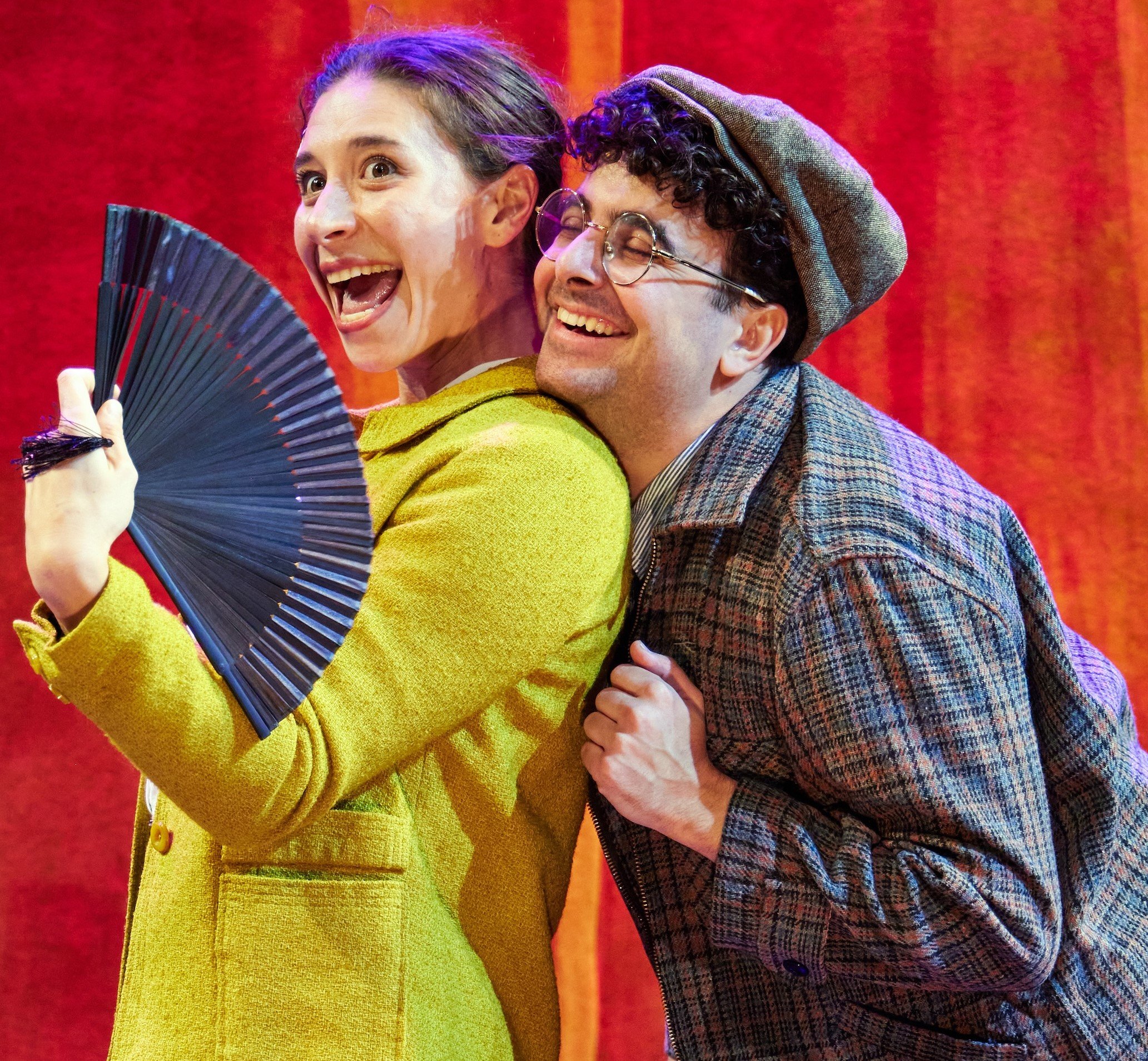Sore (Abby Goldfarb, left) and Esther (Yael Eden Chanukov) sing “Shoyn Genug (Enough Already)” to their oppressors.
It may seem contradictory—perhaps even cavalier and disrespectful—to create a musical about deprivation and brutality in the ghettos when European Jewry’s destruction was at its height. Yet despite the death and disease under German occupation, the arts, particularly music, flourished. Writer and librettist Avram Mlotek, who curated songs from those dark days in Amid Falling Walls (in Yiddish Tsvishn Falndike Vent) has showcased just that. His co-curator and father, musical director Zalman Mlotek, and director Matthew “Motl” Didner, have enabled both Yiddish and non-Yiddish speaking audiences to share in an immersive experience. English-speaking audiences can share this experience via supertitles, projected above and at the periphery of the stage.
In a Vilna Ghetto cabaret, Yosl (Jacob Ben-Shmuel) and Sore (Abby Goldfarb) sing “Yiddish Theater Lovers.” Photographs by Jeremy Daniel.
The title song Amid Falling Walls is a poem by Hirsh Glik, who was among the many twenty- and thirty-something artists and musicians who fought as partisans in the forests and ghettos but did not live to see liberation. During the war, musicologist Shmerke Kaczerginski met the teenaged Glik, who had just written Zog Nit Keynmol (Never Say). His recorded recollections are broadcast in the show:
And Hirshke came to me in the morning and first read … and then sang this very poem. This poem became the second HaTikvah (anthem) of the Jewish people.
This famous partisan anthem and the evening’s other melodies, writ large, epitomize the strength of the Jewish resistance to Nazism. Many tunes were gathered after the Holocaust by Kaczerginski, who met survivors in Displaced Persons camps throughout Europe. Others come from the Yiddish Institute’s archives, the U.S. Holocaust Memorial Museum, and elsewhere. When combined with simultaneous alternating projections—black-and-white photos—at either side of the theater, they closely reveal European Jews’ prewar life and survival under unimaginable circumstances.
The actors, who sing and dance, are convincingly forceful, resolute, and at times even exuberant in their drive to survive, but they are archetypes rather than well-developed characters. They have names, but the audience isn’t privy to more than what they share about themselves in songs, which reflect their hour-by-hour travails.
When will all this wandering stop?
When will the end finally come?
When will there be an end to this war?
Because we can’t go on this way.
They chase us, they harass us, they torment us,
They chase us, they harass us, they torment us,
They torment us.
Steve Skybell (Modhke) and Rachel Zatcoff (Mina), whose vocal range and resonance are exceptional, shine particularly brightly, but the entire ensemble’s singing and dancing are superb, as are Frank London’s orchestration and Zalman Mlotek’s musical direction. Eli Mayer is a highly gifted dancer.
The production’s structure has nonlinear ghetto and partisan scenes and a loosely linked narrative, so in some ways it resembles a poignant musical revue. This framework strengthens the play’s focus on collective memory of tragedy and celebration of resilience through musical numbers that provide the “glue” for the show.
Partisans Khane (Daniella Rabbani) and Mordkhe (Steve Skybell) tell their enemies to go to hell.
The performers adroitly move within a space too finite for an expansive tableau, and yet with their dances, choreographer Tamar Rogoff and director Didner effect the mood swings of Jews under duress—exuberance, the ecstasy of love and pain of separation, fear, hope, and bravery. The dances are set in an underworld Jewish nightclub and other ghetto venues. Even the partisans’ movements are synchronized to their songs of defiance. Perched on wooden crates, the Warsaw ghetto fighters fiercely sing about their last stand.
Set designer Jessica Alexandra Cancino has credibly transformed this limited space into densely populated Jewish areas in and out of Nazi-controlled Warsaw, Vilna, Łódź, Kraków, Bochnia, labor camps, and hideouts for partisans—all places where the Jewish communities were at the mercy of the Nazis’ havoc-making machine.
Sobering commentaries of prominent leaders such as Samuel Zygelbojm, a Bundist (socialist workmen’s advocate) and an official of Poland’s London-based government-in-exile, are intermittently projected in superscript. Despite his efforts to mobilize the world’s leaders to the near end of Polish Jewry, Zygelboim committed suicide when he realized their inaction.
In a program note, Didner expresses the hope that through this production, “we are also doing something life-affirming and that we will add this little-told chapter to the history that we all know, so that it may never happen here.” Certainly, this production’s message of Jews’ resilience amid tragedy and sorrow is an appropriate message for events of the day.
National Yiddish Theatre Folksbiene’s Amid Falling Walls runs at the Museum of Jewish Heritage (36 Battery Place) through Dec. 10. Evening performances are at 7 p.m. Monday, Wednesday, Thursday, and Saturday, and at 6 p.m. Sunday; matinees are at 1 p.m. Sunday and 2 p.m. Wednesday. For more information or to purchase tickets, contact the box office at (212) 213-2120, ext. 606 or visit nytf.org/amid-falling-walls/.
Curator/Writer/Librettist: Avram Mlotek
Co-Curator/Music Director: Zalmen Mlotek
Choreographer: Tamar Rogoff
Director: Matthew (Motl) Didner
Scenic Design: Jessica Alexandra Cancino
Lighting Design: Yael Lubetsky
Costume Design: Izzy Fields
Sound Design: Dan Moses Schreier
Projection Design: Brad Peterson
Orchestrations: Frank London and Michael Winograd





